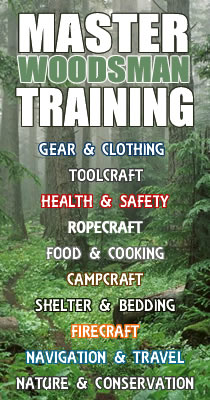Wilderness Survival is a serious subject of which we would be remiss to offer advice… that is not how we make our livelihood. In addition, nothing compares to survival instruction from a professional in the field, something you should NOT get online.
One purpose of MasterWoodsman.com® is to provide reputable sources of information including schools, literature, and more. It is also a place where Outdoor Living Skills can be put into context as we have with the other Arts & Sciences… Primitive Skills, Classic Camping, and the catch-all terms, Woodcraft and Bushcraft.
Over the last couple of decades, the line for what constitutes “wilderness survival” has been blurred by quite a few authors, schools, media outlets, etc. trying to be a one-stop shop for knowledge (and entertainment).
So what is Wilderness Survival?
Below is a concise explanation from one of our favorite books on the subject, 98.6 degrees, The Art Of Keeping Your Ass Alive by Cody Lundin.
The Modern Survival Scenario
Survival situations come in as many shapes and sizes as there are zits on a teenager, and can last for various periods of time. You can be dead in a couple minutes, hours, days, weeks, or months. However, the average survival scenario lasts for 72 hours, or three days. Statistically speaking, this is amount of time that passes before searchers find you dead or alive – as long as you have someone searching for you. The whole focus of this book is betting on the fact that you’ll be rescued within a three-day period – largely because you bothered to tell someone where you were going. This obviously does not mean that you should give up if your predicament lasts longer, but instead means you will have to try even harder. Never give up trying to survive. If you become compromised in the woods today, the chances are high that you’ll fall into the modern survival category.
Primitive Living
A primitive living situation is a long-term commitment. There is no getting rescued because you’re already home. If you find yourself in this situation, chances are your uncle is wearing a buckskin loincloth chewing on a piece of dried pack-rat meat.
Differences
There is much confusion regarding the difference between a modern survival scenario and primitive living skills. They are completely different scenarios whose main objectives overlap: the main objective in each is to stay alive, one short-term (statistically) and one long-term. For the average outdoor recreationist, primitive skills should take a backseat to learning modern survival skills if learning to survive is the main intention. In other words, discover the magic of making fire by friction after you perfect using matches.
In any event, all modern survival skills originated from primitive skills, and the beauty of knowing both is empowering. If I lose my knife, I can make one from stone. If my magnesium and matches go down the river, I have the potential to create fire with sticks.
To effectively teach modern skills, one should be well-versed in primitive skills as well. Nothing imparts the mindset of being able to do more with less and the possibilities of improvisation like living primitively. Like everything else, however, times change and with that change comes an array of modern goodies that can prove valuable to your survival…
Please see our Survival Training pages for more information on this important subject.







